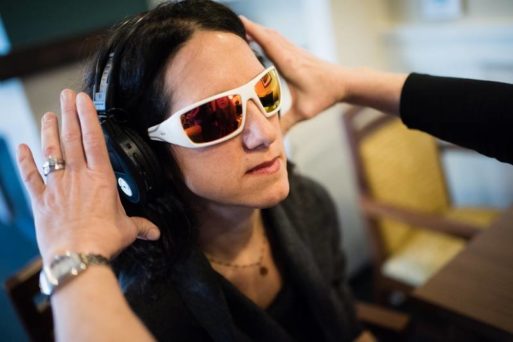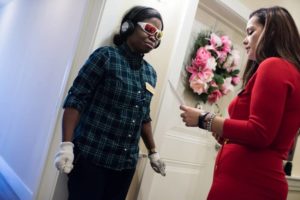The Virtual Dementia Tour is a kind of training seminar for caregivers who work with dementia patients, and it is rapidly gaining popularity across the country.
The tour seeks to create the experience of dementia for care providers participating in the session. Its purpose is to furnish a greater understanding of and empathy for people who suffer from dementia. The idea is that someone who has gone through similar mental and physical challenges will be able to provide their patients with better, more individualized, person-centered care.

Trainees are given goggles and headphones that emulate what it’s like to have dementia
Credit: WashingtonPost.com
The virtual reality system recreates dementia symptoms for the participants. The trainers also provide them with objects of clothing and sensory tools that assist in the process. For instance, they wear special goggles that make everything around them appear foggy, yellow and dark. The goggles replicate the kind of peripheral vision loss that many people with dementia experience. Macular degeneration, cataracts and yellowing are also common among aging people adding to their vision loss.
Trainees also wear over-sized gloves. These mimic the reduced sense of touch and depth perception associated with dementia, which make things very awkward to hold. Specialized headphones amplify all background sounds, as dementia patients often lose the ability to block out such ambient noises. Clanking sounds and multiple voices emanating from the headphones also contribute to a feeling of disorder. Completing the ensemble are spiky inserts for shoes. These simulate peripheral neuropathy, which causes numbness and pain from nerve damage in the extremities.
Participants are then tasked with simple, everyday actions while wearing all of the aforementioned gear. Tara Bahrampour, a reporter for The Washington Post, wrote an article recently describing her experience participating in the Virtual Dementia Tour. She took the tour at Brightview West End, a senior living center in Rockville, Maryland. Many of her anecdotes show how disorienting, stressful and frightening living with dementia must be.
For example, after Bahrampour was dressed in all the sensory equipment, a trainer read her a set of instructions. But she could only hear the words, “…fold all of the…” She responded, “I didn’t hear any of that,” to which she heard no reply. “I didn’t hear what you said,” she mentioned again, even louder. But she got no answer.

Trainees begin by listening to a set of instructions before entering a room
Credit: Washingtonpost.com
She was then led into a bedroom with a bed and dresser. Clothes lay on the bed, and plastic plates and utensils were strewn on the dresser. Since she knew “fold” was part of the instructions, she started folding the garments on the bed, but the oversized gloves on her hands made it all very awkward. Feeling confident after successfully folding some of the items, Bahrampour then decided to lay a place setting with the utensils on the dresser. But soon she began to question why she was doing this. Her mind seemed to be spinning.
She learned afterwards that many dementia patients have this same impulse to organize and straighten things in an attempt to try to control their environment.
By The Numbers
According to its website, the Virtual Dementia Tour is “the original and only patented Dementia simulation experience.” Over 2 million people in 20 countries have taken the tour since 2002. It’s been implemented in over 2,000 healthcare facilities in the United States and abroad. It is also included in the curriculum in more than 200 colleges and universities.
P.K. Beville designed the Virtual Dementia Tour. During the 1980s, she was working as a psychological evaluator of nursing home patients. It was during that time that she began to think of better ways to serve this elderly population.
When developing the tour, “I was mainly curious about how the brain dies, and what are the behavioral implications of cell death in the brain,” said Beville. She also wrote a Ph.D. dissertation about “sensitizing care facility staff to what having dementia is like,” according to Bahrampour.
Beville also has a nonprofit, Second Wind Dreams, that fulfils the wishes of people living in nursing homes. Proceeds from the tour go directly to Second Wind Dreams.
After The Tour

P.K. Bellville
Credit: Second Wind Dreams.org
Trainees learn more about what they’d just gone through at a debriefing following the training session. The tour is designed not only to limit sight, mobility and hearing, but also to disorient and confuse.
“What we did to you was create short-term memory loss,” said Patrick Doyle, director of dementia care at Brightview. “Even if you heard the task, you forgot when you went in…A lot of people say, ‘You never read me those instructions.'”
Elisa Portillo, a medication technician, participated in the same tour as Bahrampour. She said she thought that something was wrong on the bed in the room they trained in, and felt the need to fix it. Many dementia patients have this same impulse to fix something that looks out of place.
Another participant in the tour, Hermine Ngom, mentioned how she will be more likely to talk with a patient who is alone. During her experience, Ngom noticed someone (an observer from Brightview) was in the room with her, but that person did not help her. Ngom wondered why that person was just standing there and did not offer any help.
So it seems that the Virtual Dementia Tour succeeds in its purpose. Staff members at care facilities who take the tour oftentimes become more patient. And many of the care providers mentioned in Bahrampour’s story felt a greater connection to their patients with dementia after going through similar experiences. If that translates into better, more personalized care for people with dementia, perhaps we should all take the tour ourselves.

 The Virtual Dementia Tour Gives A Look Into The World of Cognitive Decline
The Virtual Dementia Tour Gives A Look Into The World of Cognitive Decline


 How Dare You Die Now!
How Dare You Die Now!

 “Help Me, Helen”
“Help Me, Helen”














